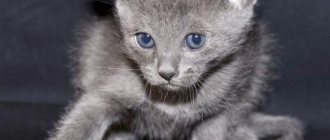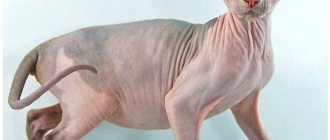History of the breed
The progenitors of this breed once lived in the Arkhangelsk province, which was located in the north of the Russian Empire. Its characteristic feature is the presence of dark blue dense wool with a silver tint.
As a rule, these gentle creatures with emerald eyes were kept in their chambers by Russian monarchs and their retinue. Peter the Great had a cat, Vaska, who could travel freely through the royal chambers, happily accepting the caresses of all the courtiers he met.
Subsequently, the heir to the royal throne, Elizaveta Petrovna, was no less loving towards her four-legged pets with blue fur. Only Catherine the Second was indifferent to such unique creatures, although quite often she presented these unique animals as gifts to overseas high-ranking guests.
Interesting guess! According to many experts, this is how the blue cat appeared in Britain at one time, when the queen presented it as a gift to the English king.
In 1893, Constance Carew-Cox brought 3 cats and one male cat from Arkhangelsk, after which she began to practice breeding this breed. No one could stop the breeding of Russian blue cats, and in 1901 another cat joined this company. These animals have always been visually different from other breeds of blue cats, both British and European, not only in their behavior, but also in their appearance.
The Arkhangelsk cat was extremely popular due to its natural grace, elegant physique, and double bluish-silver fur. They were valued because they had a fairly docile character and never made loud sounds, even during periods of heat. These cats have always been quiet, delicate and, at the same time, secretive.
✔ Russian Blue cat is a short-haired breed of blue color with green eyes
Origin and defects of selection
The history of the appearance of these cats over the many years of its fame has acquired many legends and myths.
The first mention of these wonderful mouse and rat hunters from the Arkhangelsk province of Tsarist Russia dates back to the sixteenth century.
The silvery pet Vaska lived with the Russian Emperor Peter the Great and enjoyed his favor. The love for these pets of Empress Elizabeth Petrovna and the last Russian Tsar Nicholas II is known.
The first mention of the appearance of these animals in Europe dates back to the 18th century. According to some sources, the “blue archangels,” as English sailors called them, referring to their place of birth - the Arkhangelsk region of Russia, secretly made their way onto a British ship. The occasional contraband came ashore in London and immediately became an interesting subject for English breeders. This cat was the royal favorite of Queen Victoria.
More credible is the version of the purposeful export of pedigree silver Arkhangelsk cats - three females and two males by the British breeder Constance Karen Cox in 1893 for the purpose of breeding work with a new line of cats in the European world.
The First World War, the subsequent revolution and civil war in Russia made breeding work in Russia completely impossible.
In England there was a shortage of animals for breeding Russian cats. Animals began to be crossed with other cats - blue Siamese, British Shorthair, and other representatives of this characteristic color. The breed was officially registered in this country in 1935.
The Second World War almost completely exterminated the Russian cat population in Russia and the world. A couple of silvery specimens have survived only in the English Dunloe Zoo. Due to the small number of individuals for breeding work, new genes were introduced into the cat line.
The natural characteristics of the cat have undergone even greater changes; many of its advantages have been lost as a result of world social cataclysms:
- Short double-printed wool - began to be found in isolated individuals. The silver-blue tipping has disappeared.
- The absence of odor from the animal itself and its natural secretions - the main difference between the Russian Blue and the Russian Blue has practically disappeared. Cats began to actively mark their territory during the rut, although the Russian ancestor did not have this drawback.
- Excellent silent character - Arkhangelsk cats have never screamed in estrus or during mating. The temperamental Siamese radically transformed their character.
- Significant differences in appearance appeared - an excessively tall or squat body, an uneven back, short or long legs, a predominance of the Siamese or British type in appearance.
Selection became possible again in the sixties of the last century and it began again in another country - the United States of America. Here the “blue” blood of the Russian emigrant was diluted with American shorthair, which added flaws to the original genetic appearance.
The breed returned to Russia only in the eighties of the twentieth century. Work to restore the genotype continues to this day. Russian breeders believe that this unique beauty in our country managed to regain all its natural qualities. Sometimes individuals are born with defects in their coat. But they hope to eliminate this flaw in felinology from the appearance of the Russian Blue in the coming years.
Despite its shortcomings, this animal is rightly recognized by felinologists and cat lovers all over the world; it is widespread on all continents, especially in Finland, Norway, Hungary, and other Scandinavian countries. Blue Archangels are bred a lot in Japan and the Americas.
Problems with selection
After the October events of 1917, work on breeding this breed intensified. Purebred breeding became irrelevant as the “iron curtain” was lowered on breeders. The word “Russian” was removed from the name of the breed and replaced with the word “foreign”. Only in 1939 this breed was recognized as the original “Russian Blue”.
European breeders had no choice but to start crossing similar breeds. The appearance of the Russian Blue was greatly modified by the genes of the Siamese cat, so one could notice clear signs of their presence by the following characteristics:
- The presence of a head with a straight wedge-shaped profile.
- The ears are large and widely spaced.
- Limbs are elongated.
- The coat is short and the undercoat is poorly developed.
It is important to know! The behavior of the Russian Blue also changed noticeably, as the cats began to emit loud meows, and the cats began to mark corners, which is completely unusual for a purebred Russian Blue cat. In the middle of last year, American breeders continued the practice of mixing real Arkhangelsk cats with Siamese.
As for British breeders, they took a different route, crossing them with British Shorthairs. As a result, the Arkhangelsk cat became the owner of an impressive mass and large bones.
Names for boys cats
Names from this list are perfect for Russian Blue cats:
Adams, Albert, Armani, Alan, Achilles, Baloo, Leopard, Bonnie, Best, Wulf, Viking, Gucci, Garfi, Danila, Diego, Dymok, Eroshka, Jacques, Zeus, Zulan, Invar, Indigo, Cliff, Queen, Candy, Congo, King, Lucky, Leopold, Mars, Moor, Maurice, Muscat, Nemo, Noris, Olympus, Odysseus, Patrick, Prince, Punch, Rocko, Raphael, Raymond, Spotty, Simon, Strike, Toby, Timati, Hurricane, Ursik, Fidel, Focus, Frost, Freddy, Harley, Khan, Chucky, Genghis Khan, Chubik, Storm, Shandy, Sheikh, Esmir, Andy, Ashley, Yuks, Yashka, Yasson.
If you can't decide on a name and you really like several options, try asking your cat what name he likes. Call the selected nicknames one by one and watch the cat’s reaction. Which name will he best respond to, choose it!
Homecoming
This happened in the 80s of the last century, when the first blue cats were imported from Czechoslovakia.
Unfortunately, the exterior of these cats was significantly spoiled by the genes of Siamese cats, and therefore needed the same significant adjustment. In this regard, breeders first of all set about ridding animals of these alien traits, which include:
- Profile orientation.
- Poorly developed undercoat.
- Lack of silver tint on the coat.
Without the presence of a purebred Russian Blue cat, further breeding work lost all meaning, since it was most suitable due to the fact that it was more consistent with breed standards. Russian blue cats had their main characteristics:
- The eyes are round in shape.
- Characteristic angular profile.
- The whisker pads have a characteristic swelling.
- The coat is long (moderately).
- The undercoat is dense and well developed.
- Color blue with a silver tint.
In addition, the Russian Blue cat was characterized by having a friendly, docile character, compared to the wild disposition of the Siamese.
Tips for choosing a kitten
If you decide to purchase a Russian blue kitten, then you should approach its choice with all responsibility. First of all, pay attention to the living conditions of the baby and his parents. It is recommended to buy kittens of three months of age, which should have a well-developed immune system and have received their first vaccinations.
When examining your future pet, you need to pay attention to:
- kitten eye health;
- clean ears;
- density and color of coat.
Healthy Russian Blue kittens should be active, mischievous, with an inquisitive look.
Pedigree varieties
As a result of crossing various breeds of cats with the Russian Blue cat, 4 types of Russian Blue cats appeared:
- The American type was distinguished by a pronounced manifestation of oriental features, as well as an early manifestation of the color of the iris (by 4 months of age).
- The European type has a very unique coat color and no undercoat.
- The Scandinavian type is distinguished by the presence of undercoat, has a round head and a massive body.
- The Russian type can be considered the standard version of the Russian Blue cat, although the breed is characterized by a protracted period of change in eye color, as well as unsatisfactory coat length.
Breeding Features
Females of the Russian Blue breed mature at 6–8 months, but veterinarians advise delaying the first mating until one and a half years. Pregnancy usually proceeds without complications. Its duration is 63–68 days. There are from 3 to 6 kittens in one litter.
Kittens aged 5 weeks
The cat knows how to take care of her cubs. At first, she tries to hide them from prying eyes. Feeling a threat, she will protect the offspring - she will hiss and fight. Children need to be warned about the danger and asked not to touch the kittens. Mom feeds, licks the babies and raises them. As soon as their eyes open, the cat will teach them how to use the litter box.
Appearance
The Russian Blue cat is considered a medium-sized animal, with a body weight of around 5 kg. This elegant and fit animal has a coat similar to that of British cats, while the rather thick coat visually makes the animal’s neck shorter.
We can assume that the tail is not long, and the limbs are elongated, with the hind limbs being somewhat longer than the front ones. The paws are oval shaped. The ears are quite large, the nose is straight, and the head is wedge-shaped. The whisker pads are very noticeable.
The Russian Blue's eyes are almond-shaped, widely spaced, and green in color, which gives these cats a special charm. It should be noted that the color of the iris of the eyes can have different shades of green.
Interesting to know! Kittens that are born have blue eyes, but after a long time, as they grow and develop, which can take years, the eye color will turn green.
The characteristic appearance of the Russian Blue cat is due to its dense double fur, which has a silver shimmer. An important fact to note is that the length of the coat and undercoat are almost the same. The metallic sheen is formed due to the bleached ends of the guard hairs.
If the animal is characterized as stocky, with a pronounced oriental type, as well as the presence of a round or quadrangular head, close-fitting fur, large-shaped eyes, a relatively wide tail at the base, the presence of yellow inclusions in the main color, as well as the presence of white stripes color and spots on the coat, then this can be safely attributed to breed defects.
Place for a kitten in the house
Purchasing a Russian Blue kitten is hardly a spontaneous decision. Therefore, before the baby arrives in the house, his place must be arranged and everything necessary for maintenance and care must be prepared.
At least three stainless steel or earthenware bowls: short for wet food, medium for dry croquettes, deep for water.
A litter tray, or better yet two - one smaller one will be needed for the kitten in the first months of life, and the second one will be used by the kitten as an adult. As a rule, kittens, when leaving their first home, are already litter box trained and all that remains is to decide which brand of litter to use. It is quite possible to accustom a kitten to an empty tray with a grid - it is useful and hygienic: the filler granules will not fly away in all directions and be carried around the apartment by their paws. In this case, the task of neutralizing the odor is always solved by a cleanly washed tray.
Hygiene items - brushes and combs, a rubber brush for combing out dead hair, nail clippers, a suede cloth for polishing, a toothbrush for animals, the necessary set of pet products and towels for washing. The owner must take care of the cleanliness of all these accessories in the same way as his own. A Russian Blue cat should be accustomed to grooming from childhood, and then trimming its claws or another bath will not be a shock for either the animal or the person.
Toys are a mandatory and important component of the kitten’s socialization process. With equal pleasure, the little mermaid will chase both an ordinary bow on a braid and the beam of a laser pointer.
Therefore, what matters is not how expensive or technically advanced the toy is. The main thing is that it is not traumatic (breakable, cutting, heavy) and has a suitable size: a kitten that is too large will not be interested, a small one can be swallowed. Russian Blue kittens in their usual environment are usually very active, playful and do not lose these qualities with age.
Games help you hone your technique for moving gracefully through space.
A scratching post is also a familiar item for a nursery graduate. The owner has the choice of design and size - from a modest column covered with rope to a multi-level playroom complex - this absolutely necessary device.
A carrying bag is indispensable as a means of transport for visits to the veterinarian, trips and travel.
A bed is sometimes not considered a necessary item: about 90% of surveyed cat owners allow their pets to sleep in their bed. But still, the Russian Blue should have an individual place to sleep, to which the animal must be accustomed from childhood. “Put a piece of paper in the middle of a football field, and sooner or later a cat will lie on it”: purrs love to lie on something, be it the owner’s favorite designer blouse or a stack of freshly ironed linen. And Russian Blues are no exception.
To avoid such unpleasant surprises, you will need a crib or basket for the baby. Other useful items - harnesses for walking and swimming, a collar with an address medallion, warming and antistatic bedding - can be purchased later.
Cats use their sense of smell to a greater extent than their other senses to navigate unfamiliar environments. Having gotten used to the smell inherent in the owner and relating it to a calm environment, the baby will quickly get used to the new home and begin to enthusiastically explore the new space. There is no need to prevent this, but such educational excursions should not take place unsupervised.
The owner must use every opportunity for communication and joint games, not forgetting the words of encouragement for any, even the smallest, achievement of the baby. Very soon the kitten will begin to associate home and family with the most pleasant sensations - delicious food, love, a sense of comfort and security.
Russian blue cat color
Breed standards indicate that the main color of these cats, from ears to tail to the tips of the paws, should be blue-gray, without the presence of any streaks, spots or stripes. Kittens may have a kind of “ring” on their tail, which disappears as the animal grows, although the case when this “ring” remains will not be considered a flaw. The nose should always stand out and be darker in relation to the color of the coat. The paw pads are dark pink in color.
As a rule, fashion always changes along with the preferences of the owners, so recently animals with lighter coat colors have become more in demand, although not so long ago, preference was given to darker pets.
How to choose a kitten
When choosing a kitten, you should be guided by the following tips:
- We need to adopt a three month old kitten. At this age you can judge how well he will meet the breed standards.
- The kitten's eyes should be pale green, marsh color. The color changes up to a year, so for now it will be faded. But if the kitten has yellowish eyes, it is better to refuse the purchase.
- The color of a three-month-old kitten will not change. Therefore, if now his coat is too dark and his undercoat is too thin, he will not get any prettier with age. White spots on the fur, if any, will not disappear. But you can ignore the small stripes in the tail area: they will disappear with age.
- The kitten should weigh 2 kg and be slender, elongated, with long legs and a flexible tail without kinks.
Description of character
This is a breed that is suitable for any family, including those with small children. The cat gets along both with one owner and in a family with many household members. The cat easily switches from a calm state to an active one, happily communicating with fairly active children and adolescents.
He does not allow himself to react negatively to even the most careless treatment of children, therefore he never shows aggression. The only exceptions are dogs, who for some reason really don’t like cats, and cats pay them back in kind.
They also do not allow themselves to remember grievances, so they will never dare to deliberately harm their owner. The Russian Blue cat reacts to intonation, to words and to gestures, so it can always understand what its owner wants from it: it will never dare to disobey.
Important point! Despite the fact that this pet has an easy-going character, it does not allow itself to be cuddled for a long time, especially if it is a stranger.
The Russian Blue cat is a natural hunter who can hunt anything that flies, jumps and runs. It is especially interesting to watch how a cat hunts all kinds of insects if there is no potential prey in the form of birds nearby. She will not calm down until she manages to swat the annoying fly with one throw.
Health and life expectancy
The breed does not have any genetic diseases or predisposition to certain diseases. The breeders have done a lot of work to achieve such results. But this does not mean that a cat cannot get sick. Like any other, it is susceptible to all sorts of contagious and non-contagious diseases. But many of them can be prevented by timely vaccination, proper care and a balanced diet. Average life expectancy is 13-14 years.
Maintenance and care
The peculiarity of this purebred breed is that after it there are no odors in the apartment indicating cat excretions. In addition, these cats practically do not lose hair, so it can be recommended for people suffering from allergies to cat hair. The coat will always be in order if you brush it at least once a week. It is not necessary to bathe such a pet, unless it participates in various exhibition shows. A cat sheds 2 times a year. During this period, it is advisable to include oats or grass in the animal’s diet to remove hair from the stomach.
According to some owners of this breed, the use of ready-made factory feed as food leads to darkening of the animal's coat. Therefore, you need to be careful with your diet and prepare diets in accordance with the recommendations of breeders or veterinarians. Despite this, the diet should consist of 75 percent dry food and 25 percent wet food.
The Russian Blue cat has excellent genes that are responsible for its health. A cat of this breed can live about 15 years, and with good care and maintenance, without stress, even more.
Russian Blue cat ➠ Find out everything about the cat breed
Advantages and disadvantages of the breed
This breed is valued by breeders for:
- Attractive and graceful appearance.
- No health problems.
- The short-haired breed is safe even for allergy sufferers.
- The animal is affectionate and calm.
- Strong immune system.
- Devotion.
- Easy to learn.
- Intellectually developed.
There are not many disadvantages of the breed, and they are completely insignificant:
- Be wary of strangers.
- The undying habits of a hunter.
- Demanding on cleanliness.
Purchasing a Russian Blue kitten
Pet lovers can look for a baby Russian Blue cat for themselves (to raise and care for). And beginners and professional breeders are looking for such kittens for breeding. Experienced cat breeders often know the standards, but amateurs may not understand the characteristics of the breed. Therefore, before you start searching for a kitten, you need to familiarize yourself with the basic criteria by which you can make the right choice. It is very important not to make a mistake, since a purebred animal cannot be cheap. But the price may also depend on the prestige of the nursery.
If you want a purebred kitten, then look for nurseries on Avito, then look on the Internet for everything about these specific nurseries, exclude those that have bad reviews, then call and go to choose a kitten.
VASY, forum user
https://forum.auto.ru/brothers/440561/
Criterias of choice
There are several main criteria for choosing a cat:
- Nursery conditions.
- Appearance of a kitten.
- Appearance of the kitten's parents.
- Documentation.
to buy a purebred cat, and not a simple gray kitten, you need to be guided by a number of rules
The nursery should be clean and there should be no foreign odors. Kittens offered must look neat and well-groomed. If any wounds, dull fur, etc. are obvious on the baby, then perhaps he was not kept properly. In addition, you need to pay attention to the characteristics of the breed. There should be no white or black spots in the baby's color (even white paws are unacceptable). The base coat may appear slightly striped, but this is not critical as the residual tabby will subside over time. The kitten's tail should be flexible and soft (there should be no kinks). In addition, pay attention to the color of the hairs. The very edge of the hair should be “silver” (silvering). This trait in the color of blue cats appears in kittens from 3 months and persists throughout their lives. The cat's eyes should be green (but not yellow). The kitten must also behave actively (playfulness, jumping ability, etc.).
The Russian Blue cat kitten is friendly and calm. The animal should not “shy away” when new people appear. And even more so, the kitten should not scratch, bite or growl.
If it is important for you to know what the kitten will be like when it grows up, ask the breeder to show its parents. A healthy kitten will only be born to a healthy cat, which means the baby’s mother should also look good. And also the mother must have veterinary documents (make sure she has been vaccinated). If the breeder says that the kitten or its parents have some kind of title (or award), ask for supporting documents (for example, a diploma of participation in an exhibition). In addition, if one of the cat’s parents has a pedigree, then a conscientious breeder will offer to familiarize himself with it (if a kitten is purchased, a copy of the pedigree must be handed over). And the breeder must also enter into an agreement with you, which will indicate the rights and obligations of the new owner (the need for castration, participation in breeding work, terms of purchase and sale, etc.).
If the kitten you like has yellow eyes, but the breeder assures you that this will go away, then you are being deceived
At what age can you adopt a kitten?
A conscientious breeder should not sell/give away kittens before three months of age. If a nursery gives away a kitten under this age, it means the owner of the nursery wants to save money on its maintenance. The need to get three months is due to a number of reasons:
- vaccinations;
- immunity;
- socialization.
Each kitten must be accompanied by a veterinary passport with vaccinations. Basic mandatory vaccinations are given up to 12 weeks. In addition, if the kitten you like is suitable in age, the breeder must provide contact information for the veterinarian who administered these vaccinations. Another important reason for this rule is immunity. The fact is that early weaning of a kitten from its mother can lead to negative consequences. With cat's milk, the baby receives primary immunity. If the kitten is fed other foods too early, digestive tract problems may occur.
The cat also teaches its cub some skills: going to the litter box, licking itself, playing, etc. Weaning a kitten early will lead to the development of a problematic character.
It is not recommended to adopt a kitten under 3 months old











